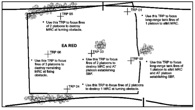Tactics 101 031 – The Engagement Area
During the leader’s recon, there are several things that must be confirmed or denied from the previous analysis. These include: 1) the true key terrain in the area; 2) the existence of decisive terrain; 3) the existence of natural obstacles; 4) the true mobility corridors and avenues of approach; 4) the cover and concealment in the area of operations.
A great technique for conducting the recon is to drive the enemy’s avenue of approaches into and through the area of operations. This enables the commander to see the terrain as the enemy would. This allows the commander to determine where the enemy wants to go, where the terrain may force him to go, his rate of maneuver, his maneuver formations, where he might change formations, where he will establish support by fire positions, his potential responses to your actions etc…
{default}After analyzing the enemy and himself and walking the terrain, the commander now can identify where he wants to achieve success in defensive – in other words where he would like to position his engagement area. We will discuss this in detail in the next section.
3. Where do you want to Achieve Success? The most important action of the leader’s recon (and in the planning, preparation, and execution of the defense) is for the commander to determine the location of the engagement area. With the determination of the engagement area, the commander is defining where he wants to destroy or contain his opponent.
In establishing an engagement area, the key element is the determination of target reference points (TRPs). A target reference point is defined as an easily recognizable point on the ground –this can be natural or manmade (manmade can simply be driving a large engineer picket into the ground) to initiate, distribute, and control fires. They can be used to define sectors of fire within the engagement area.
Let’s give a practical example of how this can work. After the commander and his leaders have accomplished the previously discussed steps in building an engagement area, they meet together in the general defensive area. The commander will then designate TRPs on the ground to accomplish the purposes he wants achieved. These TRPs will lay out the formation of the engagement area. Again, TRPs may be natural features on the ground or they can be manmade and emplaced on the terrain.
In formulating the engagement area, one technique is for the commander and his subordinates to move within the proposed engagement area. The commander then stops at locations where he wants a specific task and purpose accomplished and names that a TRP. If it is not associated with a natural terrain feature, the commander can simply stick a stake into the ground and name it a TRP.
Here is an example of a company commander giving his intent in the EA:
* Before we discuss steps 4-6, please remember these actions are not completely sequential. In most cases, the planning and preparation are conducted concurrently. This is done to assist in integrating the effects of obstacles, direct fires, and indirect fires to their fullest.
[continued on next page]



mr sutherland please drop me aline. been waiting for some time now.
This is serious work. Why is it made so difficult to follow it? As far as I can tell…one must tediously seek articles in this series by paging through all the stuff in the college page by page?
Surely there must be a better way?
Mike In Phoenix
Mike, on the ACG home page type “Tactics 101” in the search box; be sure you enclose Tactics 101 in quotation marks. That will bring up links to each article in the series.
TY, GDS,
Will do…have the folks at AG considered adding the wikibook function? Might be outstanding.